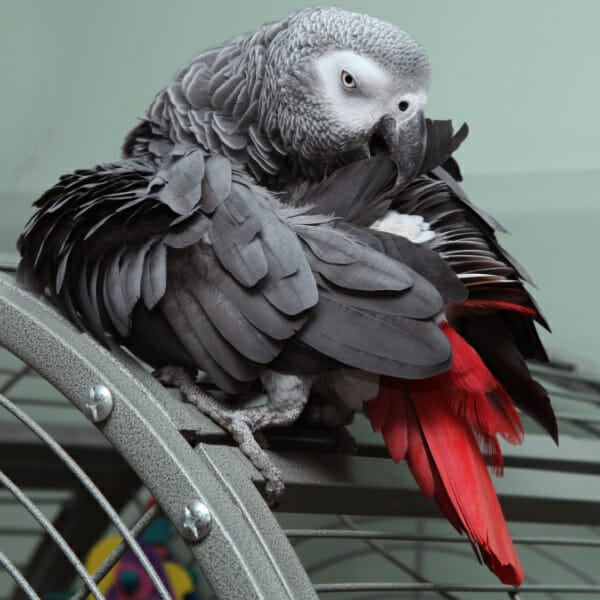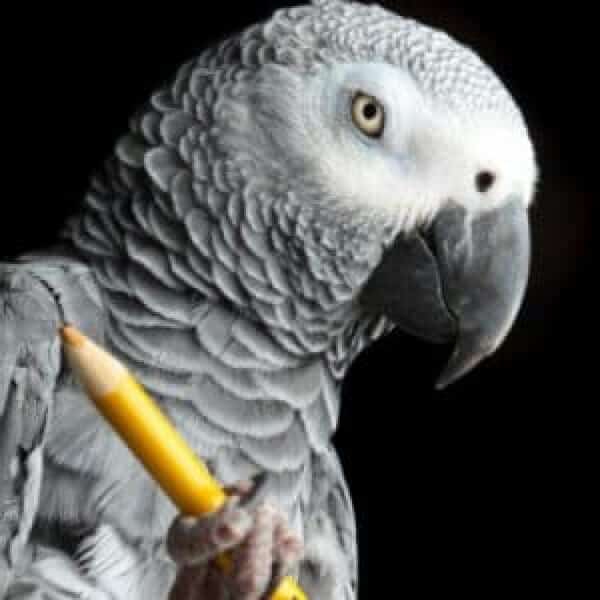Last Updated on by Catherine Tobsing
Your African grey may have upwards of 8000 feathers. Feathers keep a bird warm, and dry and enable flight.
For a molt to occur, the old feather must be removed. Before molting begins blood vessels that support the feathers dry up so the attached feather becomes loosened by the surrounding tissue.
Thus if a molt is occurring naturally, the feather follicle (bud) will start a new feather before the old one has completely left the bird’s body.
editors note: When folks walk into the shop and tell me they have an African grey they are always taken aback when I ask “what kind”?
Actually more like a deer in the headlights.
African greys come in 2 flavors Congo and Timneh. Congos can weigh up to 450 grams, Timnehs – 300 grams (a Pategonian conure is bigger than a Timmy) Thus a Timneh may need a smaller perch, and food size – just an fyi.
end note
In a simplified way yes, the new feathers push out the old feathers.
Usually, downy feathers in healthy parrots are used to stay warm in a cool environment.
Duster birds like cockatoos, African greys and cockatiels have down that disintegrates.
The resulting dust creates a lubricant and waterproof substance. The dust/powder is spread across the bird’s body as the bird preens.
African greys (as well as Amazons and Cockatoos) will first have what’s called a baby molt at around eight months old. Smaller birds may start as soon as they are fledged.
Most birds molt once a year.
These cute little soft downy feathers will seem to explode from your bird’s body requiring lots of vacuuming.
Then about three months later (11 months old) a grey will start the real molt.
Usually starting with the outer wings, molting is perfectly symmetrical. What is ever lost on the right side of the body is lost on the left side of the bird’s body.
The inner wing feathers will follow. Next the tail feathers onto the contour feathers and so on.
An African grey gets its shape and coloring from the contour feathers which are the outermost ones on their bodies.
That first molt can take up to three years.
It’s important to note here that although feathers seem dead in that you can cut them like a human’s hair and nails As feathers are coming in they will have blood inside the shafts.
A feathers shaft will have a purple-blue color when it’s still alive and if the feather shaft gets cut it will bleed a lot.
The feather shafts start as a hollow base which is named a quill or calamus. The rest of the feather shaft is called a rachis.
Small barbules on top of individual barbs which are the feathery side or vane of the feather keep the feathers “zipped”.
If a feather breaks during that growth, it usually should be removed either by you or your veterinarian but it needs to be done sooner or later because of bird can easily bleed out and die – yes from the blood loss of a single feather.
This is why it’s a good idea should you elect to clip your bird, never do it during the molt because you may be cutting into feathers whose shafts are filled with blood.
After the baby molt, all the feathers basically come out on the second molt which will occur at about 18 months of age.
During the secondary molt, all the baby feathers are replaced by adult feathers.
If you take a look at your African grey’s tail after the molt you’ll see that end of baby tail feathers kind of almost look smudged or black.
If your bird is healthy he or she will only lose a couple of feathers from each side of the body at a time.
The secondary molt comes on quicker than the first molt but will be ongoing for several months during which time all the feathers will be replaced.
Diet plays an important part in the molting process as a bird’s metabolism increases up to 30%.
Pellets are recommended to be introduced but if your bird is on a seed diet a full-range supplement should be introduced to ensure proper nutrition.
Light cycles play a huge part in signaling birds when to molt. Unless you have full spectrum lighting over the cage on a timer with lights coming on and off every 12 hours your bird is relying on ever-changing North American lighting cycles.
The circadian clock, located in the pineal gland contains a group of cells that chemically isolate, which is their way of “ticking” much like musicians use metronomes.
This can be very confusing to a bird and is one of the leading causes of screaming, plucking, and other hormonal behavior.
Many chemicals affect the molt. Cytokine (chemokines) – is used in cellular communication and it’s been noted that this signaling chemical increases at the beginning of a molt.
Melatonin is the actual chemical that signals the bird when to molt but it has nothing to do with feather loss or growth. It’s a hormone and it is found in the pineal gland. Melatonin is considered the timekeeper hormone.
LH (Luteinizing Hormone aka Interstitial Cell Stimulating Hormone or ICSH) is the hormone that gets ovulation started in female birds and in male birds it triggers testosterone production.
Progesterone is created in the ovaries of birds during their reproductive cycle.
Thyroxin (thyroid hormone) is given to chickens at a near-toxic level in order to trigger their molt but we are not sure if this hormone triggers a pet bird’s molt.
If your bird is exhibiting brooding behavior like crawling under the couch or looking for boxes (nests) to crawl into or being extraordinarily snuggly with one person they may be going through a reproductive cycle.
Nutrition plays an even more critical role because nutrients are being depleted by the calorie burn from both the molt and the reproductive cycle.
As I stated before if your artificial lighting is not synchronized with normal sunrise and sunset birds might experience abnormal molt cycles.
If you’re observing abnormal feather formation, that usually points to a poor diet, and/or the bird is under stress.
Birds can be stressed by the simple moving of a piece of furniture or piece of artwork on the wall so it’s important to pay attention to your bird’s demeanor.
If you haven’t been weighing your bird on a regular basis and your bird has been experiencing health problems that you’ve not noticed, a molt can often bring these health problems to the surface.
You may want to bring your bird in for a checkup during a severe molt to avoid making the problems worse than they already are.
You’ll also want to look for things called stress bars on your birds feathers and insure the feathers are getting a constant blood level of nutrients. If the bird is too warm or too cold or has other environmental issues, all can lead to feather stress bars.
Molting can also be a gateway to feather plucking as the bird tries to remove the annoying pending feathers coming into its body.
Rub your bird’s head in the middle of a molt and you’ll feel hundreds of tiny needles coming out of their scalp – please be extra kind during “the molt”.
Written by Mitch Rezman
Approved by Catherine Tobsing
Your zygodactyl footnote
Author Profile
Latest entries
 Bird BehaviorJune 13, 2025Why Do Some Parrots Struggle in Captivity?
Bird BehaviorJune 13, 2025Why Do Some Parrots Struggle in Captivity?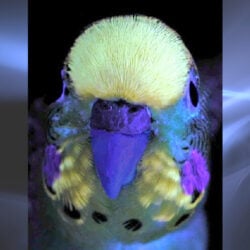 Bird & Parrot AnatomyJune 12, 2025Why are Budgerigars Called The Colorful Parrots?
Bird & Parrot AnatomyJune 12, 2025Why are Budgerigars Called The Colorful Parrots?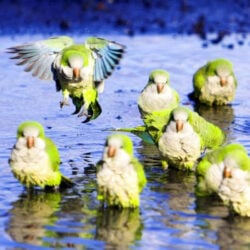 Bird & Parrot AnatomyJune 12, 2025How Do Monk Parakeets Talk to Each Other?
Bird & Parrot AnatomyJune 12, 2025How Do Monk Parakeets Talk to Each Other? 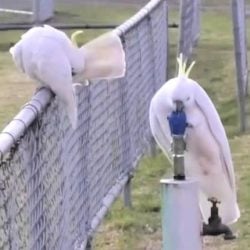 Bird BehaviorJune 10, 2025How Cockatoos Learned to Use Drinking Fountains Like People
Bird BehaviorJune 10, 2025How Cockatoos Learned to Use Drinking Fountains Like People
